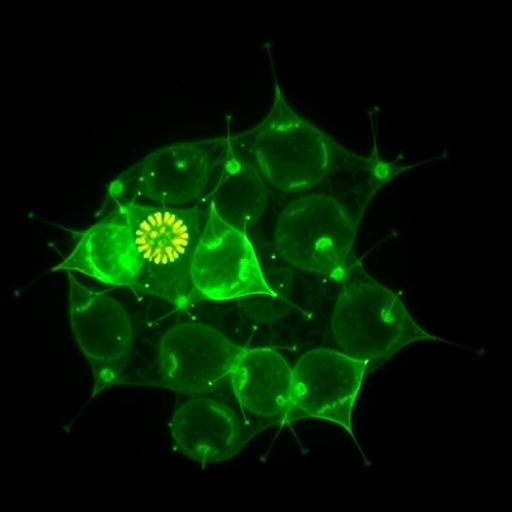
In the complex realm of cellular biology, unraveling the intricate mechanisms behind genome organization continues to advance at a rapid pace. A groundbreaking study published recently in Nature Communications sheds new light on the pivotal role played by SMCHD1, a chromatin-modifying protein, in preserving the architectural integrity of the human genome within myoblasts—specialized precursor muscle cells. This investigation reveals how SMCHD1 acts as a guardian of heterochromatin, in turn orchestrating genomic compartments and shaping the broader epigenome landscape, thereby influencing gene regulation and cellular identity.
Genomic DNA is not simply a linear sequence wound randomly inside the nucleus; rather, it is meticulously folded into highly organized three-dimensional structures. These configurations, such as topologically associating domains (TADs) and genome compartments, are crucial for regulating gene expression, replication timing, and maintaining genome stability. While it has been known that multiple protein complexes participate in establishing chromatin architecture, the precise molecular players that ensure proper compartmentalization and maintain heterochromatin domains have remained elusive. The current study positions SMCHD1 as a vital player in this high-fidelity orchestration.
SMCHD1, or structural maintenance of chromosomes flexible hinge domain-containing protein 1, belongs to a family of proteins involved in chromatin compaction and gene silencing. Prior research has implicated SMCHD1 in X-chromosome inactivation in female cells and in repressing certain autosomal genes. However, its broader role in genome compartmentalization and epigenomic maintenance in human muscle progenitors had not been extensively explored. Huang and colleagues employed state-of-the-art chromatin conformation capture techniques, coupled with epigenomic profiling, to interrogate SMCHD1’s function within human myoblasts.
.adsslot_NBSQmwajzp{width:728px !important;height:90px !important;}
@media(max-width:1199px){ .adsslot_NBSQmwajzp{width:468px !important;height:60px !important;}
}
@media(max-width:767px){ .adsslot_NBSQmwajzp{width:320px !important;height:50px !important;}
}
ADVERTISEMENT
Through a combination of Hi-C, ChIP-seq, and RNA-seq analyses, the team demonstrated that loss of SMCHD1 disrupts heterochromatin integrity, resulting in the erosion of repressive chromatin marks such as H3K27me3 and H2AK119ub. These modifications are hallmarks of silent chromatin regions, and their disappearance correlates with aberrant gene activation and disturbed genome compartment boundaries. This finding underscores SMCHD1’s essential role in preserving heterochromatin niches that insulate genomic regions and prevent inappropriate gene crosstalk.
Remarkably, the disruption in heterochromatin was accompanied by a profound remodeling of genome compartmentalization. Normally, the genome segregates into distinct active (A) and inactive (B) compartments, which facilitate spatial proximity of co-regulated genes and epigenetic states. The study revealed that SMCHD1 depletion led to weakened compartment strength, blurring the borders between active and inactive regions. Such a loss of compartmental fidelity can severely affect cellular function by misregulating gene networks critical for myogenic differentiation and muscle homeostasis.
Further insights emerged from examining the epigenome-wide distribution of histone modifications and DNA methylation patterns. With SMCHD1 loss, the repressive chromatin landscape eroded, and there was a notable decrease in DNA methylation at specific genomic loci. This epigenetic destabilization suggested that SMCHD1 operates as a scaffold not only for higher-order chromatin condensation but also for recruiting and maintaining the enzymatic machinery responsible for epigenomic modifications. This newly uncovered function expands our appreciation for SMCHD1 as an indispensable modulator of both chromatin topology and biochemical landscapes.
The consequences of these molecular perturbations extend beyond mere structural changes. The researchers observed that the disruption of heterochromatin and genome compartments influences transcriptional programs in human myoblasts. Genes typically repressed by heterochromatin became aberrantly expressed, potentially derailing the tightly regulated process of muscle cell differentiation. This insight hints at an important role for SMCHD1 in muscle development and regeneration, which may have implications for muscular dystrophies and other myopathies where epigenomic disorders are observed.
Additionally, the elucidation of SMCHD1’s multifaceted role provides a framework for exploring its involvement in disease contexts. Mutations in the SMCHD1 gene have been linked to rare congenital disorders such as Facioscapulohumeral muscular dystrophy (FSHD) and Bosma arhinia microphthalmia syndrome (BAMS). Understanding how SMCHD1 maintains chromatin compartmentalization and epigenetic stability opens new avenues for therapeutic interventions targeting chromatin regulators in these conditions. This study thus bridges fundamental chromatin biology with translational potential.
A striking aspect of this research is the comprehensive integration of various omics technologies coupled with elegant genetic perturbations. Utilizing CRISPR-Cas9 mediated knockouts, the authors precisely ablated SMCHD1 in human myoblast cultures, allowing a direct evaluation of functional consequences. This approach combined with Hi-C’s high-resolution three-dimensional genome mapping enabled a holistic view of both structural and functional chromatin alterations, underscoring the power of such interdisciplinary methods in decoding cellular complexity.
Moreover, the discovery that SMCHD1 affects epigenome landscapes in a genome-wide and cell-type-specific manner challenges previous paradigms that assigned it a more localized role. The broader impact on chromatin compartmentalization suggests that many so-called architectural proteins may have dual roles, integrating structural organization with epigenetic regulation. This conceptual advancement may inspire future studies to revisit chromatin modulators with new perspectives, investigating their contributions to genome-wide regulatory networks.
The findings also speak to the dynamic plasticity of the epigenome during muscle lineage commitment. Myoblasts must tightly regulate genome architecture to ensure proper gene expression cascades during differentiation into myotubes. SMCHD1 emerges as a critical stabilizer amid this dynamic environment, highlighting how chromatin architectural proteins safeguard epigenetic memory and genomic stability during cellular transitions. Disrupting such components could thus underlie diverse pathologies stemming from epigenetic misregulation.
Beyond human myoblasts, there may be broader implications for understanding SMCHD1 function in other cell types and organisms. Given its conserved structural features and roles in chromatin maintenance, this protein might be a universal regulator of genome topology and epigenetic landscapes across different tissues. Investigations into other stem and progenitor cells could reveal shared mechanisms by which SMCHD1 coordinates chromosomal architecture and epigenomic programming, potentially influencing development and disease beyond muscle biology.
In summary, this seminal work by Huang and colleagues expands our molecular comprehension of how heterochromatin and genome compartments are maintained within human myoblasts. By positioning SMCHD1 as a master regulator of chromatin topology and epigenetic landscapes, the study opens new frontiers in the field of genome biology, highlighting how structural maintenance proteins are central to cellular identity and function. These revelations hold promise for novel interventions aimed at correcting epigenetic dysregulation in muscular and other human diseases.
As research continues to dissect the complex interplay between chromatin architecture and gene expression, the identification of SMCHD1’s pivotal functions enriches our toolkit for understanding genome regulation. This could have profound ripple effects, influencing diverse biomedical fields from regenerative medicine to cancer biology where epigenetic integrity is frequently compromised. The convergence of chromatin structure and epigenome fidelity epitomizes the next frontier in decoding the cellular instructions embedded within our genome’s three-dimensional organization.
The publication of this research signals a transformative moment in chromatin biology, an era where unearthing the molecular architects of genome organization guides our grasp of health and disease. SMCHD1 exemplifies how proteins can bridge structural and epigenetic dimensions, stabilizing the genomic “architecture” that underpins cellular life. Future studies will undoubtedly build upon these foundations, aiming to harness chromatin regulators for therapeutic innovation, fostering breakthroughs in treating genetic and epigenetic disorders.
Subject of Research: The role of SMCHD1 protein in maintaining heterochromatin, genome compartments, and the epigenome landscape in human myoblasts.
Article Title: SMCHD1 maintains heterochromatin, genome compartments and epigenome landscape in human myoblasts.
Article References:
Huang, Z., Cui, W., Ratnayake, I. et al. SMCHD1 maintains heterochromatin, genome compartments and epigenome landscape in human myoblasts. Nat Commun 16, 6900 (2025). https://doi.org/10.1038/s41467-025-62211-0
Image Credits: AI Generated
Tags: advances in cellular biology researchcellular identity and gene expressionchromatin-modifying proteins in gene regulationepigenetic factors in myoblast differentiationepigenome landscape in muscle cellsmechanisms of chromatin architecturemyoblasts and genome organizationpreserving genomic architectural integrityprotein complexes in chromatin stabilitySMCHD1 role in heterochromatin maintenancestructural maintenance of chromosomes proteinstopologically associating domains in genomics






